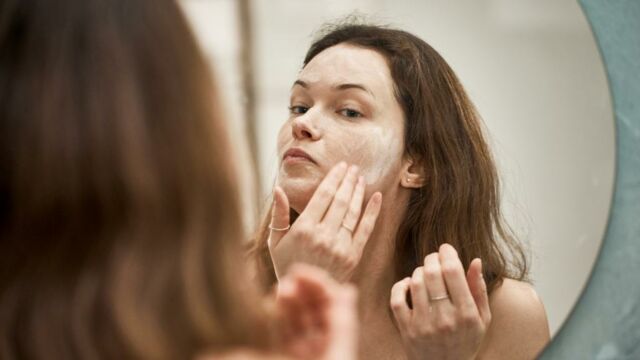Everything you need to know about fungal acne

It might surprise you to know that fungal acne isn’t actually acne at all. Here’s everything you need to know about what fungal acne is and how to treat it.
If you’re a skincare fanatic or even just a TikTok regular, you’ll probably have seen someone show off their fungal acne routines full of salicylic acid and green tea extracts. However, skincare specialists on social media have finally broken the news - fungal acne isn’t a class of acne at all.
Discover our latest podcast
What is fungal acne?
Commonly known as fungal acne, Pityrosporum folliculitis, or Malassezia folliculitis is actually an infection of the hair follicle.
More under this adMore under this adFungal acne or hair follicle infections are inflamed, itchy and often look like lots of tiny pimples - hence the name. These infections are caused by a yeast known as Malassezia, which is part of the fungi family. Malassezia naturally exists on everyone’s skin, but overgrowths can sometimes happen in hot and humid weather or even when a person sweats.
Like regular acne, fungal acne can affect the face, but it can most commonly be found in clusters on the chest, back and areas of restrictive clothing.
More under this adMore under this adWhat triggers fungal acne?
As mentioned, there are a few things that can cause an infection of the hair follicles:
Antibiotics
Long term use of antibiotics such as clindamycin, doxycycline and minocycline can often cause fungal acne. This is because antibiotics kill off both good and bad bacteria, giving the yeast a place to thrive. Those who take oral antibiotics forcystic or hormonal acne may find themselves experiencing fungal acne during their course.
Hygiene
Sweat can be a huge trigger for fungal acne. If you’re the type of person to have an avid gym routine, then make sure your clothes aren’t too restrictive and shower straight after to avoid any chances of infection.
More under this adMore under this adSkincare products containing oils
This one may come as a shock, but yeast actually feeds on oils. Using facial oils or other oil-based skincare products could trigger a fungal acne breakout.
Diet
Diet and acne have a complicated relationship, and fungal acne isn’t exempt from this. While diet may not directly cause fungal acne, high sugar diets can provide food for the yeast to thrive.
More under this adMore under this adCOVID masks
One place you can expect to find humidity and bacteria is under your mask. If you find that you are getting fungal acne around the lower part of your face, it may be because of your mask. Switching from disposable to reusable cotton or silk masks may help to reduce both regular maskne and fungal acne in this area.
What are the best ways to treat fungal acne?
Some cases of fungal acne will require prescription treatment. However, there are many things you can try at home to battle the yeast on your face.
More under this adMore under this adDandruff shampoo
It seems strange, but dandruff shampoos contain yeast killing ingredients. Like the classic Head & Shoulders, these shampoos can even be found in your local grocery store or pharmacy. All you need to do is apply some of this shampoo to the affected area, wait ten minutes and then wash it off.
Benzoyl peroxide
Benzoyl peroxide is a class A fungal acne treatment. This ingredient can come in the form of a cream or cleanser and has antibacterial properties, helps to unclog pores and aids in the exfoliation of skin cells. Unfortunately, although it’s great at killing bacteria produced by the yeast, benzoyl peroxide isn’t antibacterial, which means it won’t fight off the yeast itself. But, if your fungal acne is only mild or you also have other treatments, benzoyl peroxide can still be beneficial.
More under this adMore under this adSalicylic acid cleanser
Salicylic acid is found in many acne targeted skincare products from cleansers to toners to creams. This acid is keratolytic, which means that much like benzoyl peroxide, it helps to act as an exfoliant and shed dead skin cells. Salicylic acid is also antibacterial and antifungal, killing both fungal acne-causing bacteria and the yeast itself.
Prescription creams
If your fungal acne isn’t responding to at-home treatment, a doctor or dermatologist will be able to prescribe high strength treatments such as ketoconazole cream 2%.
More under this adMore under this adWith harsh products such as benzoyl peroxide, salicylic acid and prescription creams, it’s important to remember not to overdo treatments. Using these products too often can cause damage to the skin’s moisture barrier and provide further irritation. Instead, use these products a few times a week and make sure you also follow up with a nourishing oil-free moisturiser and an SPF in the daytime.
Hygiene
When exercising, ensure you wear breathable materials, and once you’re done, change into clean clothes as soon as possible. It also pays to have wet wipes handy to remove sweat if you can’t make it to the shower straight away.
More under this adMore under this adOil-free skincare
Swapping to oil-free moisturisers and skincare products will help to ensure the yeast doesn't have anything to feed on.
Diet
If you believe your diet may be causing your fungal acne, try cutting back on the sugars - this includes high sugar fruits and processed carbs.
Fungal acne can take several weeks to treat, so don’t feel discouraged if it doesn’t subside straight away. If you feel like your fungal acne is uncontrollable, it’s best to consult a doctor or aesthetician.
More under this ad